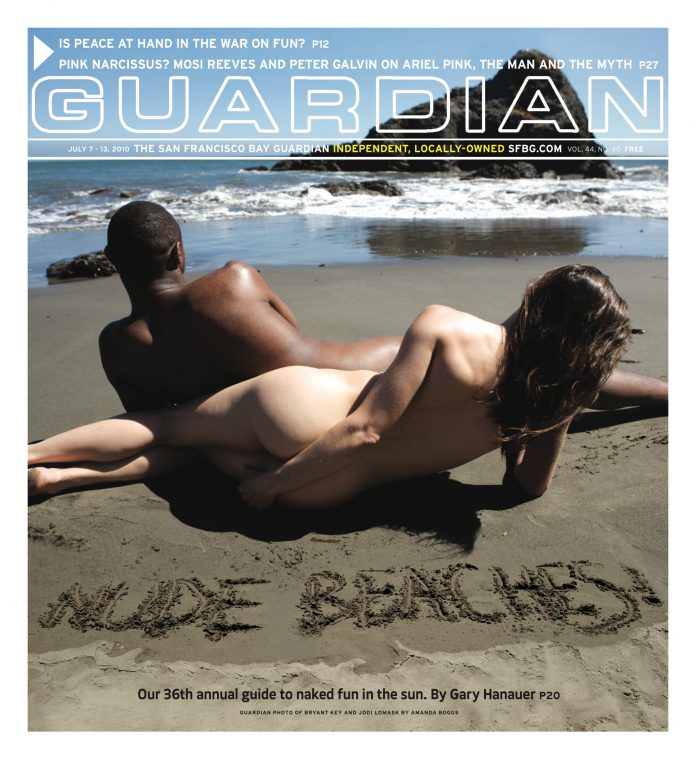arts@sfbg.com
ART Let’s start with the obvious: the massive art collection of Gap Inc. founders Doris and the late Don Fisher is by far one of the largest and most significant windfalls SFMOMA has received in its 75-year history. More important, the collection — which had primarily been viewable throughout the Gap’s SF headquarters only by company employees and visiting tour groups — is finally being made accessible to the general public.
Gary Garrels, SFMOMA’s senior curator of painting and sculpture, has selected 160 works — a mere fraction of the 1,100 total — for “Calder to Warhol: Introducing the Fisher Collection,” a Fishers’ Greatest Hits that aims to provide an overview of the breadth of their holdings as well as highlight their in-depth focus on certain artists. During the exhibits media preview, Garrels mentioned that the Fishers acquired pieces without the help of advisers, jointly choosing works that “spoke to them.” Clearly, they had a taste for big game.
Primarily comprising paintings and sculpture, “Calder to Warhol” is, as its title indicates, a veritable who’s who of mid-to-late 20th century modern art that takes over the museum’s top two floors and spills out into the rooftop sculpture garden. I’m not being facetious when I say there’s something for everyone. Aside from extensive collections of Calder and Warhol, the show is chockablock with iconic pieces by Ellsworth Kelly, Gerhard Richter, Cy Twombly, Richard Serra, Roy Lichtenstein, Chuck Close … and the list goes on.
The range of artists and quality of the pieces assembled is dizzying. Take the fourth floor, for instance. The shock of several hideous, large-scale mixed media on aluminum DayGlo monstrosities by Frank Stella from the late 1970s and ’80s is largely soothed by the blushing, meaty pinks and reds of The Street, a remarkable 1956 Philip Guston abstract canvas in an adjoining gallery (Guston gets an additional gallery all to himself), which then leads to the downy embrace of Lee Krasner’s equally stunning 1961 oil Polar Stampede — a palimpsest of brown and gold hatch-marked feathers — and from there a gallery of four decades of Twombly’s looped scribbles.
Then there’s the small collection of Agnes Martin paintings, which by itself would be worth the price of admission. Martin is an artist who particularly suffers in reproduction: the delicate lines and gentle washes of color in her paintings get lost, and all one sees are their grid-like skeletons. Being able to study up close the subtle pop effect of the squares in Night Sea (1963) — the way in which the gold leaf underneath the oil causes the canvas’ tiny bluish squares to flash teal — is a revelation.
Or, starting from the floor’s north end, one encounters a crash course in Pop Art and its kin. The Lichtensteins and the Claes Oldenburg apple core are all well and good, but the Warhols are where it’s at: standouts are early 1960s silkscreens such as Tunafish Disaster and two of the handsome criminals in the “Most Wanted Men” series, and lesser-famous portraits of Joseph Beuys and Robert Mapplethorpe alongside Dolly and Jackie’s familiar visages. These aren’t the usual Factory hits.
Around another corner, past a room crowded with Close portraits, is another must-see: two enormous Sigmar Polke canvases from his alchemical 1988 series, “The Spirits That Lend Strength to the Invisible,” on which the German artist applied unconventional materials such as tellurium, chemical resin, and ground-up meteors. Their wild, particulate sprays evoke both the Hubble Telescope’s images of space, as well as the crude plumes currently floating off the Gulf Coast.
And I haven’t even started in on the fifth floor, with its showcases of Important Works by Calder, Kelly, Serra, Kiefer, Richter, and some particularly wonderful Lewitt wall drawings.
Yes, “Calder to Warhol” is dizzying. It is also frequently dazzling. But I can’t help but feel a little squeamish in the face of such a grand and copious cache; one that until recently had been displayed as an act of corporate largesse to those in the service of the empire that funded its acquisition.
Art collecting is a form of investment, capital put down toward ensuring the collector’s future legacy as much as it is a reflection of aesthetic tastes. The Fishers rarely sold pieces, and the equal attention they paid to collecting both figurative and abstract works — as well as an earlier failed bid to construct a private museum in the Presidio — suggests that the collection was developed increasingly with an eye toward creating the very sort of jaw-dropping endowment of which SFMOMA now finds itself the very fortunate recipient.
Certainly for SFMOMA, the benefits of this gift are clear. The museum’s profile has undoubtedly risen, and will continue to rise once the planned expansion set to house the remaining 90 percent of the collection’s holdings is complete. What remains less apparent throughout “Calder to Warhol” is a sense of the Fishers’ personal investment in the pieces they so assiduously acquired. To simply say that the art — so much amazing work, now finally on view — speaks for itself is only half true. As with any major private collection, it also speaks to a long campaign waged over the peaks and valleys of the art market.
Still, the Fishers aren’t merely the sum of their deep pockets. I wish the wall panels revealed when each piece had been bought, and whether Don or Doris had singled it out first (Imagine their dinner conversations: “Honey, would you like to buy a Dan Flavin?”). That information would put a different, perhaps more humanizing, spin on the story “Calder to Warhol” currently tells: a testament to the Fishers’ wide-reaching, frequently well-informed, and relatively safe taste for blue chip names.
CALDER TO WARHOL: INTRODUCING THE FISHER COLLECTION
Through Sept. 19, $9–$15
(children under 12 free; first Tuesday of every month free)
SFMOMA
151 Third St., SF
(415) 357-4000

